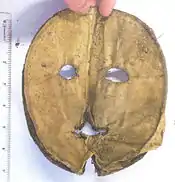


A visard (also spelled vizard) is an oval mask of black velvet, worn by travelling women in the 16th century to protect their skin from sunburn.[1] The fashion of the period for wealthy women was to keep their skin pale, because a tan suggested that the bearer worked outside and was hence poor. Some types of vizard were not held in place by a fastening or ribbon ties, and instead the wearer clasped a bead attached to the interior of the mask between their teeth. [2]
The practice did not meet universal approval, as evidenced in this excerpt from a contemporary polemic:
When they use to ride abroad, they have visors made of velvet ... wherewith they cover all their faces, having holes made in them against their eyes, whereout they look so that if a man that knew not their guise before, should chance to meet one of them he would think he met a monster or a devil: for face he can see none, but two broad holes against her eyes, with glasses in them.
— Phillip Stubbes, Anatomy of Abuses (1583)
In Venice, the visard developed into a design without a mouth hole, the moretta, and was gripped with a button between the teeth rather than a bead. The mask's prevention of speech was deliberate, intended to heighten the mystery of a masked woman even further.[4]
England and Scotland
A Spanish observer at the wedding of Mary I of England and Philip II of Spain in 1554 mentioned that women in London wore masks, antifaces, or veils when walking outside.[5] In Scotland in the 1590s Anne of Denmark wore masks when horse riding, to protect her complexion from the sun.[6] These were faced with black satin, lined with taffeta, and supplied with Florentine ribbon for fastening and for decoration.[7] At the Union of Crowns in 1603, she travelled to England in June, and it was said she had done "some wrong" to her complexion "for in all this journey she hath worn no mask".[8]
In 1620 the lawyer and courtier John Coke sent clothes and costume from London to his wife at Much Marcle, including a satin mask and two green masks for their children.[9] Visards experienced a resurgence in the 1660s, as Samuel Pepys notes in his diary on June 12, 1663: "Lady Mary Cromwell... put on her vizard, and so kept it on all the play; which of late is become a great fashion among the ladies, which hides their whole face."[10] Later that day, Mr. Pepys bought his wife a vizard.[11]
Citations
- ↑ Holme (1688).
- ↑ Elgin (2005).
- ↑ Portable Antiquities Scheme (2010).
- ↑ Steward & Knox (1996), p. 56.
- ↑ Viaje de Felipe Segundo á Inglaterra (Madrid, 1877), p. 77: M. Channing Linthicum, Costume in the Drama of Shakespeare and his Contemporaries (Oxford, 1936), p. 272.
- ↑ Michael Pearce, 'Anna of Denmark: Fashioning a Danish Court in Scotland', The Court Historian, 24:2 (2019), p. 142 doi:10.1080/14629712.2019.1626110
- ↑ Jemma Field, 'Dressing a Queen: The Wardrobe of Anna of Denmark at the Scottish Court', Court Historian, 24:2 (August 2019), p. 163 doi:10.1080/14629712.2019.1626120
- ↑ Maurice Lee, Dudley Carleton to John Chamberlain, 1603-1624 (Rutgers UP, 1972), pp. 34-5.
- ↑ HMC 12th report part I, Earl Cowper, Coke (London, 1888), p. 108.
- ↑ Pepys, Samuel. “June 12, 1663.” The Diary of Samuel Pepys': Selected, with an Introduction by Richard Le Gallienne, The Modern Library, New York, New York, 1967, pp. 100–101.
- ↑ Pepys, Samuel. “June 12, 1663.” The Diary of Samuel Pepys': Selected, with an Introduction by Richard Le Gallienne, The Modern Library, New York, New York, 1967, pp. 100–101.
See also
References
- Elgin, Kathy (2005). Elizabethan England. Infobase Publishing. p. 38. ISBN 9781438121239.
- Holme, Randal (1688). The Academie of Armorie.
A mask [is] a thing that in former times Gentlewomen used to put over their Faces when they travel to keep them from Sun burning... the Visard Mask, which covers the whole face, having holes for the eyes, a case for the nose, and a slit for the mouth, and to speak through; this kind of Mask is taken off and put in a moment of time, being only held in the Teeth by means of a round bead fastened on the inside over against the mouth.
- "Mask". Portable Antiquities Scheme. 2010.
- Steward, James Christen; Knox, George (1996). The mask of Venice: masking, theater & identity in the art of Tiepolo & his time. Berkeley Art Museum and Pacific Film Archive. ISBN 9780295976112.
External links
- Details of a visard in the collection of the Norwich Castle Museum
- A miniature visard made for a 17th-century child's doll in the collection of the Victoria and Albert Museum


